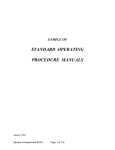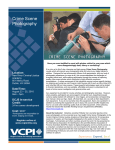Download ETM 1/4 COVER (Page 1)
Transcript
The magazine dedicated exclusively to the technology of evidence collection, processing, and preservation Volume 5, Number 5 • September-October 2007 Forensic Video Analysis SOME OF THE TOPICS IN THIS ISSUE ■ Establishing a forensic video unit ■ Interview: Meeting the challenges of digital video ■ Selecting AFIS search parameters ■ Underwater crime-scene investigation techniques Photo courtesy of Sepia Productions considerations for establishing your own FORENSIC VIDEO UNIT T HE MANY STEPS that you must take toward establishing a forensic video unit may vary dramatically depending on the size of your department or its goals, but key issues can be divided into two basic categories: the equipment and the people who operate that equipment. Steve Brown operates Sepia Productions, which provides all of the forensic video services for the Long Beach (California) Police Department, one of only four such video units in Southern California. Brown stresses the importance of budgeting for adequate equipment because the technician’s expertise by itself can only do so much. Expecting to achieve usable evidence with “off the shelf” equipment is not realistic, he said. “The reality,” Brown said, “is that in order to do video forensic work, you need to be able to take surveillance tapes—either digital or analog—and go frame by frame, looking for those ‘gold nuggets’ that give detectives the leads. Those things are found by the enhancement—not manipulation—of the images. And contrary to popular 12 Written by Dale Garrison belief, you can’t do that with just a popular Photoshop program.” At least 70 percent of Brown’s work today is with digital images and the remainder is with analog. As a result, several systems are needed to handle the entire process, but the core of his analysis work is performed by Ocean Systems dTective®, one of three or four systems currently on the market. Regardless of the brand you select, Brown urges careful examination to ensure that the choice fits the department’s needs. “You need to do your homework on the different systems to see what fits your budget and which works best for you,” he said. “For example, if you want to be able to de-interlace multicam systems, then you need the hardware and software for that. The bottom line is, you want to be able to do what I call ‘unraveling the knot’ of the images to make it possible for your detectives to view them.” Brown also cautioned against assuming that video evidence is always going to be available, or that any system can always produce usable results. “When the detectives bring something in, the first thing we need to do is see that there’s something there,” he noted. “There are times when you just don’t have anything. But once you see that you do have something, then you go in and perform the surgical work on the portions that have suspect information.” Brown stressed that enhancement is not manipulation of the image, but involves steps to highlight or better distinguish what is there. Quite often, a simple still image pulled from a video is all that is needed. In other cases, the analyst will need to spend hours or days not only on the enhancement process, but also preparing detectives to present that information in the courtroom. The practical economics of an up-to-date forensic video unit Although the expenses for equipment and training can be substantial, recent cases tend to illustrate the value of good forensic video analysis. Brown recalled one case when a prosecutor came by one evening with potential video evidence from a carjacking that the prosecutor thought might help, although she held little hope for find- Evidence Technology Magazine • September-October 2007 www.EvidenceMagazine.com F O R E N S I C ing detailed evidence. Brown and his staff spent two hours going over the tape to extract still frames, enhancing and printing them. The next day, the prosecutor called and said the suspect had plead out that morning—in tears—because of the photographs. “She told us that we had saved the city $80,000 to $100,000 in courtroom costs. That’s pretty good for two hours.” Brown tells such stories because he believes they explain the importance of adequate budgeting for video forensics. “We do 25 to 30 cases a month,” he said. “There are a lot of times when you don’t get much, but if you just get one or two cases a year that save that kind of money, it’s worth it. You can’t afford to not have a productive video forensics unit.” While the expertise needed for the work is important, it should not deter the average police department from pursuing the work. “You don’t need a PhD. Any police officer who wants to do this can get access to the training,” said Brown. “It helps to be computer savvy to start with. I don’t want to simplify it too much—but if you can read a manual and use a computer, you are on the right track.” Brown was certified for arson and crime-scene video several years ago, and recently added more advanced V I D E O Although the expenses for equipment and training can be substantial, recent cases tend to illustrate the value... or return on investment ...that a police department can realize from forensic video analysis. training, including evidence photography and videography certification. Brown stressed that even with a sophisticated forensic analysis system, it is important not to manipulate or improperly handle images, which must be handled as carefully as any other evidence. Technical image characteristics or measurements such as “hash readings” and pixel dimensions must be rigidly observed, something an amateur with only minimal understanding can miss entirely. “The dTective System does things like highlighting that helps pull your image toward what you want to see,” he said. “But it is enhancement, not manipulation. It is enhancing the information that is already there. That is the difference.” Steve Brown of Sepia Productions conducts forensic video services for the Long Beach (California) Police Department. Brown provided these images to illustrate what can be retrieved from video through enhancement. The original video image (on the left) reveals virtually no information. But after working on the video with the dTective Sysem from Ocean Systems, Brown was able to obtain something useful (on the right). Notice that only the left side of this image has been enhanced through highlighting. The right side has been left unchanged to emphasize the difference. Evidence Technology Magazine • September-October 2007 www.EvidenceMagazine.com Administrators in charge of budgets at most agencies tend to focus first on the acquisition cost of the equipment, which can be considerable. Although dTective and other systems are PCbased, the entire system with all the necessary equipment can cost $25,000 to $90,000, depending on the level of work intended. Forensic video work also remains something of a frontier—and for that reason, good analysts also may be required to use considerable resourcefulness. “We used to have just one VHS player,” Brown noted. “But some of these surveillance tapes have been stored in a liquor store or some place for a year, and the only thing that would play them is an old player with the heads worn down. Often, we’ll try different players to see which works.” Digital data is no less complex. The technician must be familiar with the hundreds of formats that are used to encode digital video in order to find the one that will open images from a proprietary security system, for example. Sometimes, they must visit locations to help extract the tape or data because the owner is unaware of how to do it. “We’ll sometimes sit there and read the user’s manual until we are able to figure it out,” he laughed. Chain of evidence is a relatively simple chore—provided it is done 13 F O R E N S I C IMAGE AS IT WAS RECEIVED V I D E O IMAGE AFTER BEING CORRECTED Jason Latham, video analyst with the Johnson County (Kansas) Sheriff’s Department Criminalistics Laboratory, provided these images to illustrate how incorrect handling can cause image distortion. As he explains below in this article, the image on the left was captured and processed by a computer that altered the horizontal and vertical aspect ratio—and the distortion caused it to look like a station wagon. After being corrected, it is obvious that the vehicle is an SUV instead of a station wagon. “Most lay people would see that (original) image and think it looks right,” Latham said. “But the analyst will know that something isn’t right there.” Are these the same image? correctly. “We have a huge, thick safe and each case that we are studying is secured in its own envelope,” he said. Even a simple still image can bring an immediate plea from a suspect, but Brown urges technicians to avoid boasting about their expertise in the courtroom. “You should never claim to be an expert on the stand,” he said. “Just let them see that you know what you’re doing. Just let the evidence speak for itself.” Staffing the unit with well-trained personnel Jason Latham, a video analyst with the Johnson County (Kansas) Sheriff’s Department Criminalistics Laboratory, also emphasizes the importance of using the right equipment, although he especially focuses on the side of the equation that factors in expertise. To Latham, no amount of equipment by itself can substitute for knowing how to use that equipment effectively—a point he makes in his work and in lectures that he presents for the Law Enforcement and Emergency Services Video Association (LEVA). Latham is especially concerned that the increasing sophistication of some equipment has made it almost too easy for untrained users to jump right into the analysis process, thereby creating some potential problems. “A detective will sometimes walk up to a tape player and start pushing 14 the pause button so he can see a frame,” Latham said. “Right there, they’ve done damage to that tape. I see a lack of understanding about the technology that can really hinder the process.” Similar but more sophisticated issues arise with “turnkey” systems that help automate the process for the technicians. Without a thorough understanding of the basic principals, some evidence—or even some cases—can be lost. “You push what I call ‘the magic button’ and get results,” Latham said. “And that worked pretty well in the analog day, but now with DVR, pushing the wrong button can destroy evidence. A one-week vendor class doesn’t make you an expert. They are trying to do the right thing, but there are a large number of people who are overextending the technology and making faulty solutions.” Latham recommends beginning the process of establishing a forensic video unit with training. Programs by groups such as LEVA, the Scientific Working Group on Digital Evidence (SWGDE), and the Scientific Working Group on Imaging Technology (SWGIT) can provide an overview of the discipline before an agency commits itself to spending money on the equipment. Latham also suggests that those who are entering the field of forensic video analysis should understand the various levels of expertise and their limits. “I define two levels: technicians and analysts,” he said. “A technician understands what they are looking at and how to produce a reliable picture. An analyst truly analyzes the data and ‘interrogates’ that video witness. The analysts are the ones who get into the important details of image analysis, reverse projection, color correction, and authenticity work—the type of analysis that requires a thorough understanding of the work.” Latham also uses some real-world examples to illustrate how even simple errors can cause problems. Consider a common situation, for example, where a local police department received a digital image. “The computer that captured and processed the video images altered the horizontal and vertical aspect ratio,” he said. “Due to this distortion, a vehicle might look like a station wagon when it is actually an SUV. As a result, the police might pull over the wrong vehicle. Or you get an estimate of the height and weight of a suspect that is totally wrong. Most lay people would see that image and think it looks right, but the analyst will know that something isn’t right there.” Latham takes his personnel priority one step further. He strongly advises any department that has a significant workload to dedicate a staff member to the discipline full time. “That way you have one person who becomes expert at this discipline. That is their Evidence Technology Magazine • September-October 2007 www.EvidenceMagazine.com F O R E N S I C primary emphasis,” he said. “With that comes a commitment to training. These individuals should be going to one or two training events a year.” Structure the budget around appropriate equipment Budgeting for equipment is also more than a one-time issue. “You don’t buy a single computer and think it will last forever,” he said. “This is like DNA equipment—it’s expensive. You need to constantly update and maintain it.” According to Latham, departments that are shopping for equipment should contact several vendors and use realworld evidence as a test before they decide to buy. “A lot of samples the vendors use are from cases that they know their equipment will work well on,” he explained. “So bring them the cases you have. Bring the most awful video you’ve seen, and use that to test their equipment. Then go to another vendor and compare the results.” Despite the sometimes-daunting learning curve and budget issues, the most high-tech systems and years of experience are not always needed. “If you just want to print images, particularly from a DVR system, you can do this if you have the right equipment and some training,” Latham said. “There are resources being developed just for that. If you have a decent computer system and capture card, you can use these to print accurate images for the V I D E O courts. But if you need an analysis of the images, then you may need to examine other issues.” And regardless of equipment, some video-imaging material will simply not be usable. “There will be data that you just can’t do anything with,” he said. “That’s part of the learning curve, too.” Despite all of this, another priority involves something as old as police work: written operating procedures. “That’s what differentiates science from art: repeatable results,” Latham said. “You should be able to send off the same data and someone else can get similar results using your policies, your procedures, and your protocols. The may not be exactly the same results, but they will be similar. You are adhering to sound, scientific principals that the courts can rely on.” There is no doubt that bringing video evidence to the courtroom can have dramatic results. Unfortunately, the drama can sometimes work against law enforcement if the evidence is not properly collected and presented. Latham cited recent instances where evidence was thrown out because of improper processing. “I think part of that is the result of not having the training—of someone thinking that just pushing a button does the job. I am not willing to fault the analysts because they are often pushed into this and expected to produce with- Evidence Technology Magazine • September-October 2007 www.EvidenceMagazine.com out really getting the support they need. They get what amounts to a three-day class in analysis and then they are told to ‘go do video.’” Understanding and following the correct procedures can be daunting to departments and individuals: peer review, technical review, accreditation, and practice. Another factor may be an odd twist on the “CSI Effect,” the way the popular TV media tends to oversimplify the process of forensics. “I think some departments have the idea that there is equipment that will do this and all you do is push the magic button,” Latham said. “It’s not like that.” One thing that is not debatable is the growth of forensic video analysis. In some ways, the technology is where fingerprinting was 60 or 70 years ago, with only some departments operating in-house units. But with the proliferation of capture devices, the need is growing astronomically. “Years ago, most departments did not have fingerprint-analysis capability, but now they all do,” Brown concluded. “That’s the way forensic video analysis is today. Most don’t have it. But people are seeing that you can’t afford not to have it.” ❍ ❍❍ About the Author Dale Garrison is a freelance writer based in Liberty, Missouri. He can be reached by e-mail at this address: [email protected] 15











![KeyView [4823353_1.wpd]](http://vs1.manualzilla.com/store/data/005667242_1-589c8deb81b55e7c0d34a0d078158765-150x150.png)









